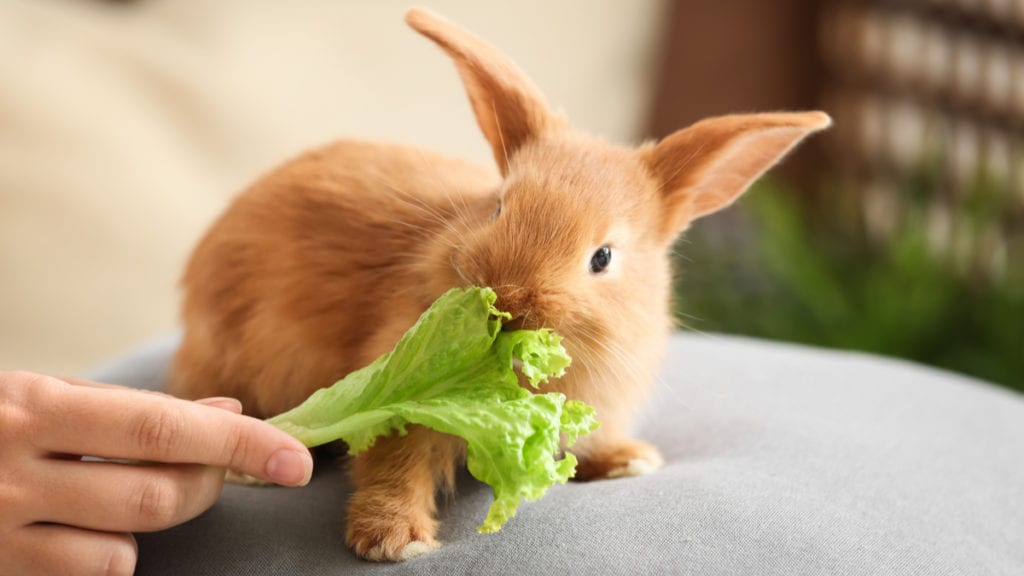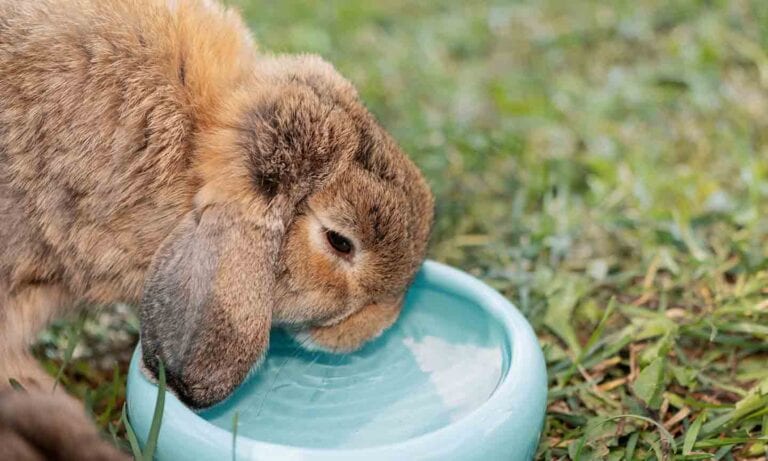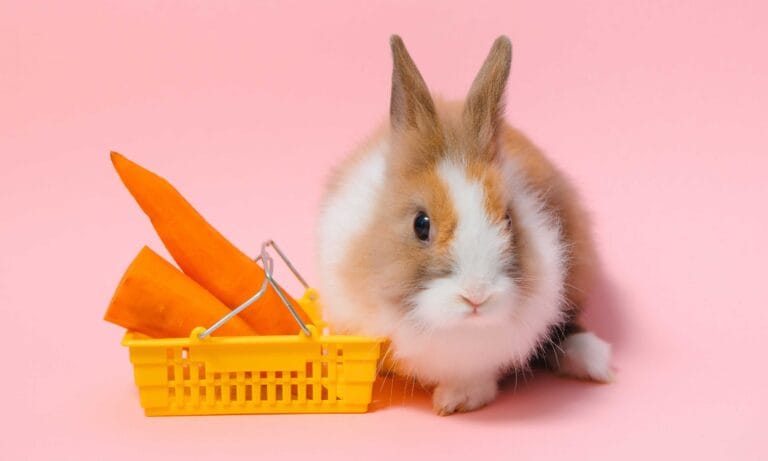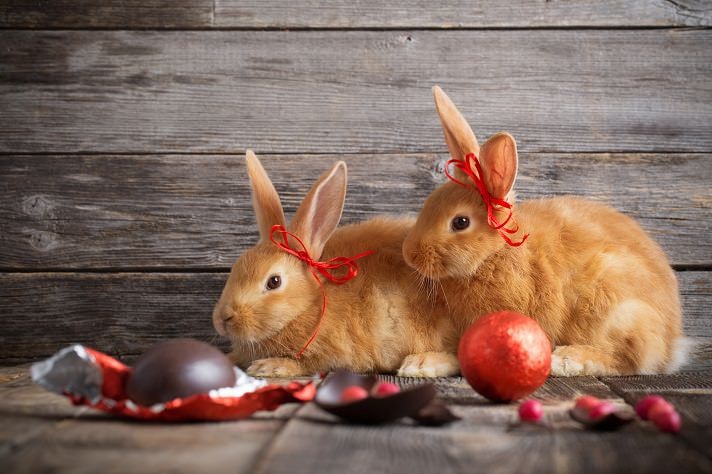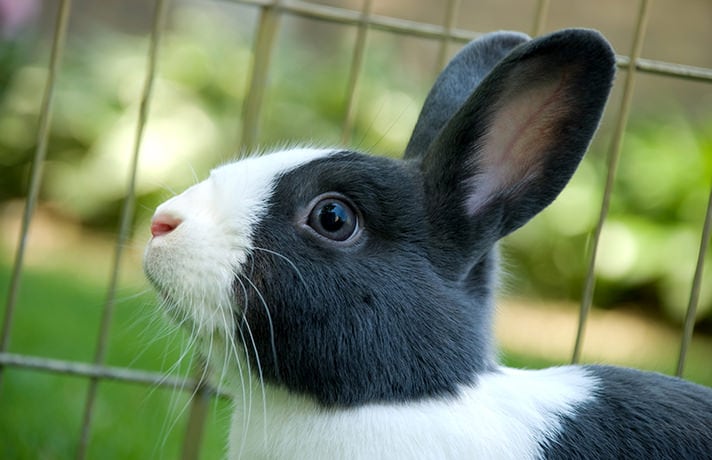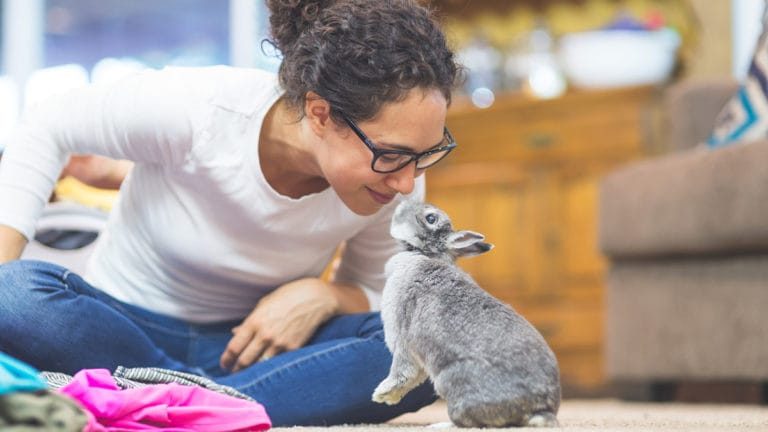Understanding the unique digestive anatomy and physiology of rabbits gives us a greater understanding of how best to feed these critters—optimizing their health and avoiding common diet-related diseases.
How Do Rabbits Compare?
When it comes to eating, rabbits are probably more similar to cows, horses and guinea pigs than cats, ferrets, rodents and dogs. Unlike cats and ferrets, which are obligate carnivores, and dogs, rats and mice, which are omnivores, rabbits are herbivores. Like cows, horses and guinea pigs, rabbits are designed to graze throughout the day, rather than ingest their daily ration in a single sitting. While it is normal for dogs and cats to eat once or twice a day, a rabbit that goes without food for a day may be seriously ill.
Unlike cattle, which have four stomachs to digest their food, rabbits are monogastric, meaning they have one stomach. While humans, horses, dogs, cats, rats, mice, ferrets and hamsters are also monogastric, the rabbit has the largest stomach in relation to his body size of any of the monogastric animals. Of the small animal pets, the rabbit’s digestive system is probably most similar to the guinea pig.
After the stomach, the next largest element of the digestive system in both rabbits and guinea pigs is the cecum or hindgut. It contains a population of gut flora or natural bacteria that ferment the high-fiber diet these critters were designed to eat. If the population of normal flora is eliminated, it is impossible for rabbits or guinea pigs to digest fiber properly. Ensuring a consistent throughput of good-quality fiber keeps the gut flora happy and healthy, and it is vital for maintaining health.
Both rabbits and guinea pigs pass soft, mucus-covered fecal pellets called cecotropes, which they proceed to eat. Cecotropes are a critical source of vitamins, minerals and nutrients—and ensure that the gut is repopulated with healthy flora. Rabbits and guinea pigs normally remove these directly from their bottom by grooming.
You may notice dogs, cats, rats and mice ingesting feces—while essentially the same behavior, it does not serve a nutritional purpose and is actually called “pica,” a word that refers to the eating of nonfood items. It may be harmless in these species, or it may be a sign of a compulsive disorder. It is an important distinction to make, because while it might be acceptable to discourage a dog or cat from eating excrement, rabbits and guinea pigs should be permitted to do so.
This is one reason why we try to avoid the use of Elizabethan collars in these species—it can prevent the ingestion of cecotropes, thereby altering the balance of gut flora and potentially resulting in gastrointestinal upsets.
When it comes to water, rabbits are heavy drinkers, consuming more water per pound of body weight than any other mammal. An average adult rabbit consumes approximately 1.6 to 5 ounces (50 to 150 ml) of water per 2.2 pounds (1 kilogram) per day — the same amount as a 22-pound (10 kilogram) dog and around twice that of a human. Rabbits that are hungry or bored will drink even more. For this reason it is vital to provide fresh drinking water daily.
Let’s Talk Teeth
While carnivore teeth are designed for tearing meat (think about the fanglike canine teeth you see when a dog or cat yawns), herbivore teeth are designed for grinding. In this way, rabbit teeth are very similar to horse teeth — they have evolved to grind down fibrous vegetation, such as grasses and plants.
Rabbits may move their jaws more than 120 times a minute when eating. In order to cope with this constant wear, the teeth of rabbits are open-rooted, allowing them to grow continuously. The upside is that the teeth won’t simply wear away with a high-fiber diet.
The downside is that if the diet is not high enough in fiber, the teeth will not wear down—in fact they may continue to grow, leading to abnormal wear, malocclusion (teeth don’t meet properly)—preventing effective grinding and causing the formation of spurs on the teeth and abscesses in the tooth roots and jaw.
If rabbits are not provided with enough grass or hay the teeth continue to grow unchecked, which can lead to serious dental disease. Dental disease in rabbits can manifest as inappetence, a lumpy or irregular feeling jaw, excessive salivation (“slobbers”) and abscesses around the face, particularly in the region of the cheeks and eyes.
As with horses, once dental disease in rabbits is present, the pattern of abnormal tooth wear has already set in. Correction of the problem may require multiple visits to the veterinarian for dental work under anesthetic. Dental disease can usually be avoided by providing an appropriate diet that is high in fiber.
Healthy Eating
The majority of your rabbit’s diet (around 80 percent) should consist of hay and grass, with the rest made up of vegetables (10 to 15 percent), then pellets and fruits.
If your rabbit already enjoys a diet like this, you are likely to have a happy, healthy, long-lived bunny. If not, you can take steps to change the diet, but it is important to introduce new foods slowly to ensure that your rabbit’s gut can adjust. When acquiring a new rabbit, always find out about the previous diet and replicate this as closely as possible while gradually introducing new foods.
One of the best indicators that your rabbit is coping with a new diet is the appearance of his fecal pellets. Healthy fecal pellets should be consistently sized, dark, rounded, slightly soft stools. Poorly formed or watery stools are a sign of gastrointestinal upset. Juvenile rabbits less than 3 months old are particularly vulnerable to upset.
Hay is an important source of protein, fiber and vitamins, especially vitamins A and D. Hay for rabbits includes two major categories: grass hay (timothy, oat, wheat and ryegrass) and legume hay (alfalfa, lucerne and clover). Grass hay is generally better as it is higher in fiber than legume hay. Because legume hay is very high in calcium and protein, which may lead to the formation of urinary crystals and stones, it should not be fed exclusively for any extended period of time. Young rabbits easily become addicted to the taste, and weaning them off legume hay can be a challenge.
Select the best-quality hay available. Damp hay, or hay that is stored for too long, can become moldy and toxic to rabbits.
Like hay, fresh grass is a great source of fiber, protein, vitamins and minerals. Rabbits enjoy grazing on fresh grass and can be permitted to graze the lawn if the grass is untreated. Suitable vegetables for rabbits include carrots, broccoli, peas (leave them in the pod), spinach, kale, Asian greens such as bok choy, Brussels sprouts, cabbage, celery (don’t remove the leaves — this is often their favorite part), green beans, cucumber and fennel. Herbs such as parsley, basil, coriander, mint and dill are very popular. Offer a selection of vegetables each day, and be aware that not all vegetables are good for rabbits. Portion size depends on the size of the rabbit, but a handful is usually OK.
Good-quality pelleted foods contain vitamins, minerals and nutrients that may be beneficial to your rabbit. Choose a high-quality brand that is high in fiber (at least 20 percent) and low in protein (under 16 percent), and always check the use-by date. Like us, when offered a mix rabbits tend to pick out the tastiest bits (for example, sunflower seeds) and leave the rest. If your rabbit does this, opt for a uniform pellet instead of a mix that includes loose seeds.
While we consider fruit a healthy snack, it is very high in natural sugars and too much can lead to obesity. Acidic fruits like apple, when fed in large amounts, can cause inflammation of the lips (chelitis).
At most, rabbits should be offered one or two tablespoons of fruit per day, and never any pits or seeds. Suitable fruit snacks include strawberries, apples, bananas (peeled), berries (blackberries, blueberries or raspberries), oranges (peeled), peaches, pineapple (peeled), cantaloupe, pears, nectarines or plums. If you offer your rabbit tomato, remove the leaves first.
Types Of Eaters
All-Day Grazers
The majority of rabbits prefer to graze on hay throughout the day, which is ideal as this reflects the lifestyle they were designed for. Most rabbits in the wild do exactly this—although they may be more likely to adopt a nocturnal lifestyle to avoid some predators. All-day grazing keeps rabbit teeth in tip-top shape and ensures a healthy gastrointestinal tract.
Finicky Eaters
It can be tricky to tell if your rabbit is a truly finicky eater, as some rabbits are simply shy and prefer to eat in private. Others regard new food items with suspicion. As long as your rabbit is in good body condition and consistent in his eating habits, this is nothing to worry about. If your rabbit suddenly becomes finicky, it may indicate dental disease, gut stasis or other gastrointestinal upset. Seek advice from your veterinarian if you are unsure.
Food Hounds
These bunnies love their rabbit food — a little too much. They tend to leap at any offerings, devouring them as fast as possible in the hope that more will be provided. They are prone to obesity and associated complications such as diabetes. Food hounds often prefer higher-calorie offerings, such as pellets, fruit and concentrates. Instead, these rabbits should be offered less high-calorie treats and more high-fiber hay.
Over-Adventurous Eaters
These bunnies chew on anything they can get their mouths around — from plastic bags to rubber toys to electrical cables and cat food. Such habits should be discouraged. Free-roaming bunnies should be supervised at all times and accessible areas suitably bunny-proofed (for example, ensuring all chewable items are out of reach and encasing cables in protective piping). Avoid providing cloth bedding as this is also commonly swallowed.
If you have more than one rabbit it can be helpful to work out the eating personality of each. For example, a finicky eater housed with a food hound may miss out on vital nutrients and fail to thrive. This can be countered by hand-feeding some food items to the finicky eater, or providing time out away from the food hound to graze.
More on Rabbit Diets:
- Rabbits, Wheat Grass and Hairballs
- Rabbit Food List: What Fruits and Vegetables are Safe for Rabbits?
By: Anne Fawcett, BA(Hons), BSc(Vet)(Hons), BVSc(Hons), CMAVA
Share:
